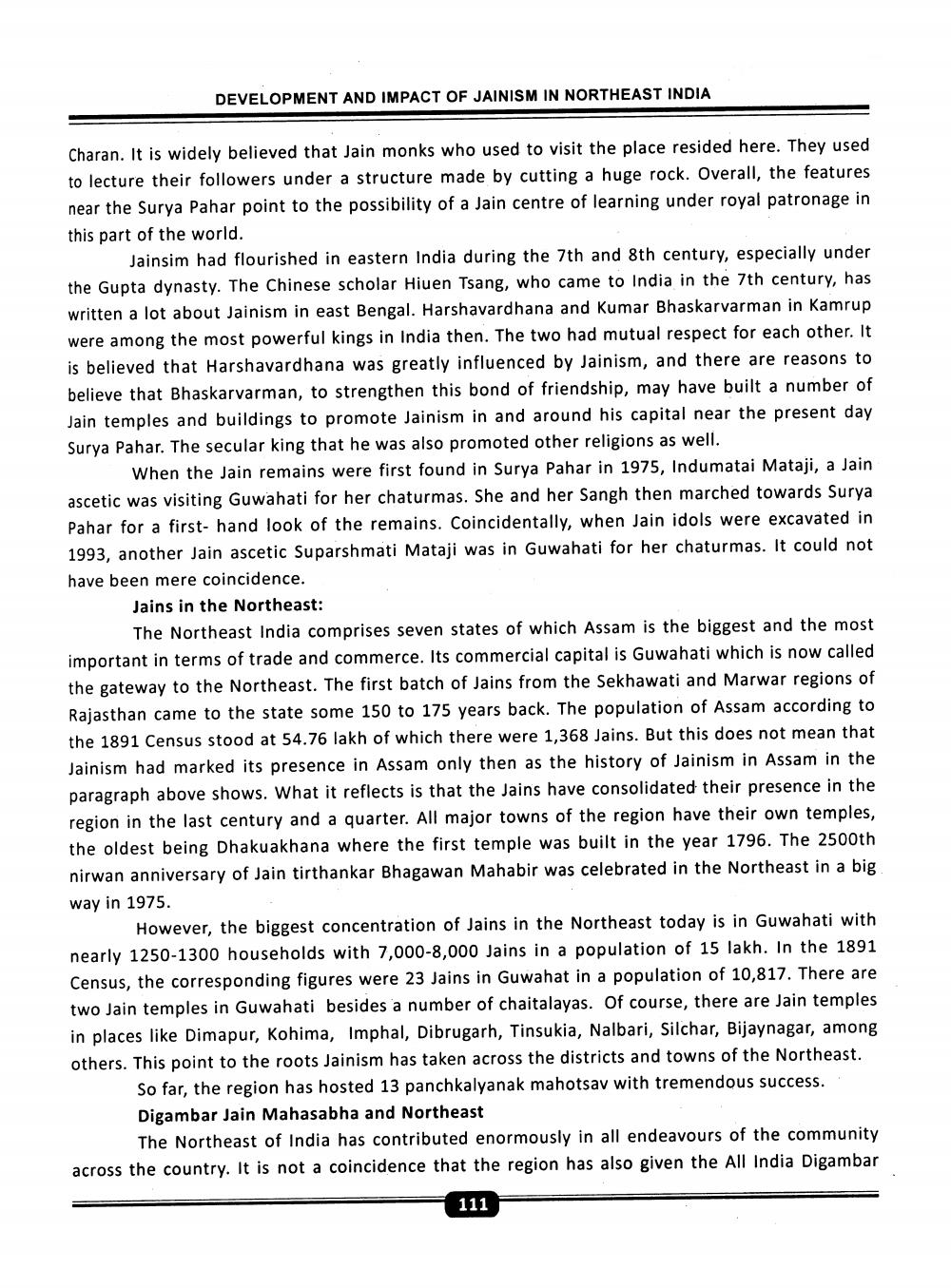________________
DEVELOPMENT AND IMPACT OF JAINISM IN NORTHEAST INDIA
Charan. It is widely believed that Jain monks who used to visit the place resided here. They used to lecture their followers under a structure made by cutting a huge rock. Overall, the features near the Surya Pahar point to the possibility of a Jain centre of learning under royal patronage in this part of the world.
Jainsim had flourished in eastern India during the 7th and 8th century, especially under the Gupta dynasty. The Chinese scholar Hiuen Tsang, who came to India in the 7th century, has written a lot about Jainism in east Bengal. Harshavardhana and Kumar Bhaskarvarman in Kamrup were among the most powerful kings in India then. The two had mutual respect for each other. It is believed that Harshavardhana was greatly influenced by Jainism, and there are reasons to believe that Bhaskarvarman, to strengthen this bond of friendship, may have built a number of Jain temples and buildings to promote Jainism in and around his capital near the present day Surya Pahar. The secular king that he was also promoted other religions as well.
When the Jain remains were first found in Surya Pahar in 1975, Indumatai Mataji, a Jain ascetic was visiting Guwahati for her chaturmas. She and her Sangh then marched towards Surya Pahar for a first-hand look of the remains. Coincidentally, when Jain idols were excavated in 1993, another Jain ascetic Suparshmati Mataji was in Guwahati for her chaturmas. It could not have been mere coincidence.
Jains in the Northeast:
The Northeast India comprises seven states of which Assam is the biggest and the most important in terms of trade and commerce. Its commercial capital is Guwahati which is now called the gateway to the Northeast. The first batch of Jains from the Sekhawati and Marwar regions of Rajasthan came to the state some 150 to 175 years back. The population of Assam according to the 1891 Census stood at 54.76 lakh of which there were 1,368 Jains. But this does not mean that Jainism had marked its presence in Assam only then as the history of Jainism in Assam in the paragraph above shows. What it reflects is that the Jains have consolidated their presence in the region in the last century and a quarter. All major towns of the region have their own temples, the oldest being Dhakuakhana where the first temple was built in the year 1796. The 2500th nirwan anniversary of Jain tirthankar Bhagawan Mahabir was celebrated in the Northeast in a big way in 1975.
However, the biggest concentration of Jains in the Northeast today is in Guwahati with nearly 1250-1300 households with 7,000-8,000 Jains in a population of 15 lakh. In the 1891 Census, the corresponding figures were 23 Jains in Guwahat in a population of 10,817. There are two Jain temples in Guwahati besides a number of chaitalayas. Of course, there are Jain temples in places like Dimapur, Kohima, Imphal, Dibrugarh, Tinsukia, Nalbari, Silchar, Bijaynagar, among others. This point to the roots Jainism has taken across the districts and towns of the Northeast.
So far, the region has hosted 13 panchkalyanak mahotsav with tremendous success. Digambar Jain Mahasabha and Northeast
The Northeast of India has contributed enormously in all endeavours of the community across the country. It is not a coincidence that the region has also given the All India Digambar
111




